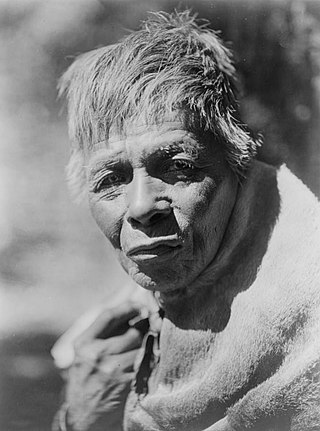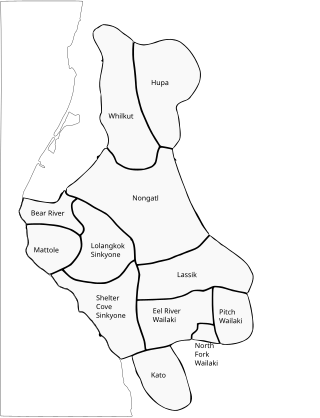Pacific Coast Athabaskan is a geographical and possibly genealogical grouping of the Athabaskan language family.

The Eel River Athabaskans include the Wailaki, Lassik, Nongatl, and Sinkyone (Sinkine) groups of Native Americans that traditionally live in present-day Mendocino, Trinity, and Humboldt counties on or near the Eel River and Van Duzen River of northwestern California.
Plains Miwok and Sierra Miwok traditional narratives include myths, legends, tales, and oral histories preserved by the Miwok people of the central California, specifically those of Sacramento Valley and Sierra Mountains. These Miwoks are the linguistically related speakers of the Plains and Sierra Miwok languages and their descendants. At the time of European entry, local groups that spoke these languages participated in the general cultural pattern of central California.
Hupa traditional narratives include myths, legends, tales, and oral histories preserved by the Hupa, Chilula, and Whilkut people of the Trinity River basin and vicinity of northwestern California. The Hupa people of modern times number in the several thousands and live in the Hoopa Valley located in Humboldt County, California.
Karuk traditional narratives include myths, legends, tales, and oral histories preserved by the Karuk (Karok) people of the Klamath River basin of northwestern California.
Kato traditional narratives include myths, legends, tales, and oral histories preserved by the Kato (Cahto) people of the Eel River basin of northwestern California.
Maidu traditional narratives include myths, legends, tales, and oral histories preserved by the Maidu, Konkow, and Nisenan people of eastern Sacramento Valley and foothills in northeastern California.
Modoc traditional narratives include myths, legends, tales, and oral histories preserved by the Modoc and Klamath people of northern California and southern Oregon.
Mono traditional narratives include myths, legends, tales, and oral histories preserved by the Mono people, including the Owens Valley Paiute east of the Sierra Nevada and the Monache on that range's western slope, in present-day eastern California.
Pomo traditional narratives include myths, legends, tales, and oral histories preserved by the Pomo people of the North Coast region of northwestern California.
Shasta traditional narratives include myths, legends, tales, and oral histories preserved by the Shasta people of northern California and southern Oregon.
Wappo traditional narratives include myths, legends, tales, and oral histories preserved by the Wappo people of the North Coast Ranges of northeastern California.
Wintu-Nomlaki traditional narratives include myths, legends, tales, and oral histories preserved by the Wintu and Nomlaki people of the western Sacramento Valley in northern California.
Wiyot traditional narratives include myths, legends, tales, and oral histories preserved by the Wiyot people of the Humboldt Bay area of northwestern California.
Yana traditional narratives include myths, legends, tales, and oral histories preserved by the Yana people of the eastern Sacramento Valley and foothills of northeastern California.
Yokuts traditional narratives include myths, legends, tales, and oral histories preserved by the Yokuts people of the San Joaquin Valley and southern Sierra Nevada foothills of central California.
Yuki traditional narratives include myths, legends, tales, and oral histories preserved by the Yuki people of the upper Eel River area of northwestern California.
Yurok traditional narratives include myths, legends, tales, and oral histories preserved by the Yurok people of the lower Klamath River in northwestern California.
Pliny Earle Goddard was an American linguist and ethnologist noted for his extensive documentation of the languages and cultures of the Athabaskan peoples of western North America. His early research, carried out under the auspices of the University of California, Berkeley, focused on the Hupa and adjacent Athabaskan groups in northwestern California. After moving to New York in 1909 at the invitation of Franz Boas his scope expanded to include the Athabaskans of the Southwest, Canada, and Alaska. During the 1910s and 1920s. as Boas's junior colleague at the American Museum of Natural History and Columbia University, Goddard played a major role in creating the academic infrastructure for American Indian linguistics and anthropology in North America.

Wailaki, also known as Eel River, is an extinct Athabaskan language spoken by the people of the Round Valley Reservation of northern California, one of four languages belonging to the California Athabaskan cluster of the Pacific Coast Athabaskan languages. Dialect clusters reflect the four Wailaki-speaking peoples, the Sinkyone, Wailaki, Nongatl, and Lassik, of the Eel River confederation.

